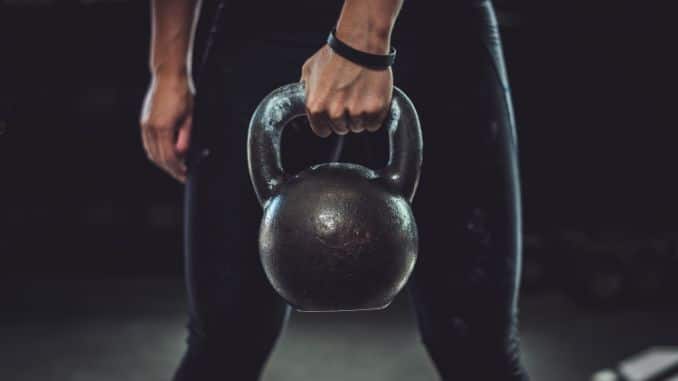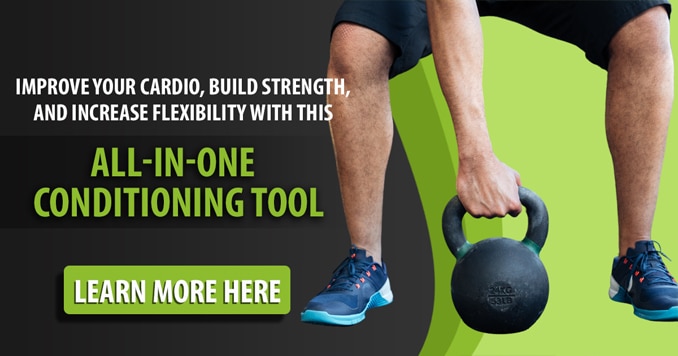Are you ready to elevate your fitness routine with kettlebell shoulder exercises? Whether you’re a beginner or a seasoned athlete, incorporating kettlebell workouts can significantly enhance your shoulder strength and stability.
In this article, we’ll explore the best kettlebell exercises for your shoulders, share insights from expert Chris Lopez, and highlight the benefits of kettlebell training [2] for your shoulders.
How to Do It: Step-by-Step Kettlebell Shoulder Exercises
Before diving into the exercises, let’s break down how to perform them correctly.
Here’s a simple guide to get you started:
1. Starting Position:
- Stand with your feet shoulder-width apart.
- Hold the kettlebell in front of you with both hands.
2. Engage Your Core:
- Keep your core muscles tight.
- Ensure your shoulder blades are retracted.
3. Performing the Exercise:
- For overhead movements, perform a kettlebell exercise by extending your arm above your head, keeping your shoulder aligned.
- For swings, hinge at the hips while maintaining a neutral spine.
4. Finish Strong:
- Control the movement back to the starting position.
- Maintain good posture throughout the exercise.
Now, let’s explore some effective kettlebell shoulder workouts!
Best Kettlebell Shoulder Exercises
1. Kettlebell Shoulder Press
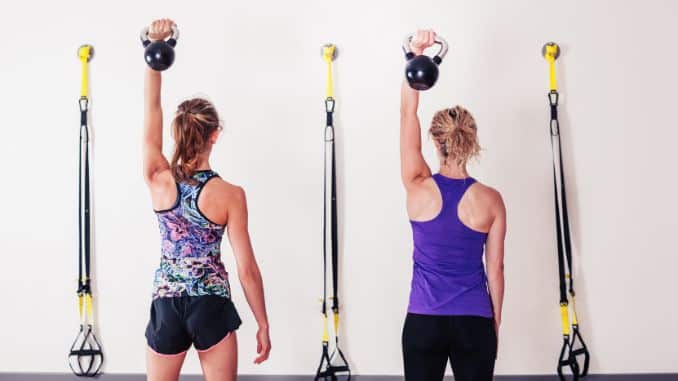
The kettlebell overhead press is fantastic for building overall shoulder strength.
- Begin in an upright standing position with your feet hip-width apart.
- Maintain good alignment with your head, shoulders, hips, and legs.
- Hold a kettlebell on one hand with an overhand grip.
- After that, engage your core muscles.
- Raise and then press your arm overhead while keeping your elbows close to your body.
- Hold the position for a few seconds.
- Lower your arm back to the starting position and then repeat the movement on the opposite arm.
2. Kettlebell Push Press

This dynamic movement combines strength and explosive power, making it an effective variation of the kettlebell press.
- Begin in an upright standing position with your feet shoulder-width apart.
- Maintain good alignment with your head, shoulders, hips, and then legs.
- After that, hold a kettlebell in each hand.
- Bend your knees to move into a squat position.
- Bend your elbows and then place your hands at shoulder level.
- After that, engage your core muscles.
- Drive through your heels and then legs to return to a standing position, using the momentum to press the kettlebell overhead.
- After that, repeat the sequence of movement with 5 repetitions.
3. Kettlebell Windmill
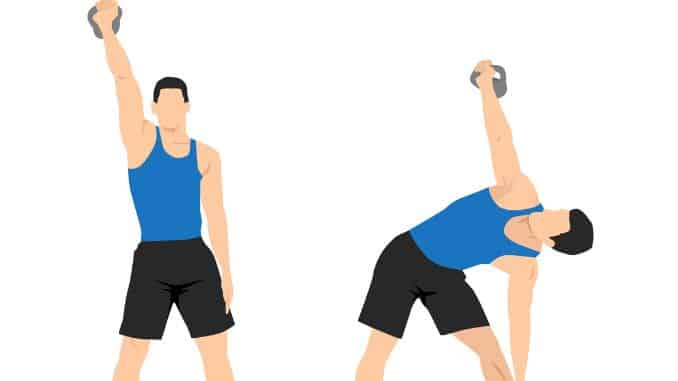
The kettlebell windmill is excellent for shoulder mobility and then stability.
- Begin in an upright standing position with your feet wider than shoulder width apart.
- Maintain good alignment with your head, shoulders, hips, and then legs.
- Hold a kettlebell in one hand and extend your arm overhead.
- After that, engage your core muscles.
- Bend at the hips and lower your torso towards the ground, reaching your other hand on your foot while keeping your arms and legs straight.
- After that, hold the position for a few seconds.
- Raise back up and then repeat the movement on the opposite side.
4. Kettlebell Clean and Press
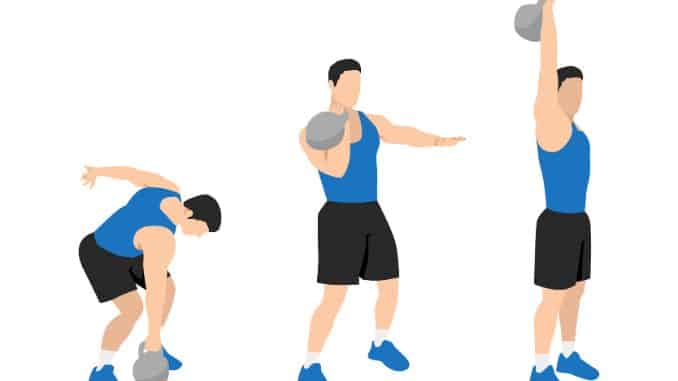
This single-arm kettlebell exercise works multiple muscle groups, enhancing strength and coordination.
- Begin in an upright standing position in front of a kettlebell with your feet hip-width apart.
- Maintain good alignment with your head, shoulders, hips, and then legs.
- Pick up the kettlebell with one hand and place your hand at shoulder level.
- Perform a clean to bring the kettlebell to the rack position before pressing it overhead in a controlled motion.
- After that, hold the position for a few seconds.
- Relax and then repeat the sequence of movement on the opposite side.
5. Kettlebell Snatch
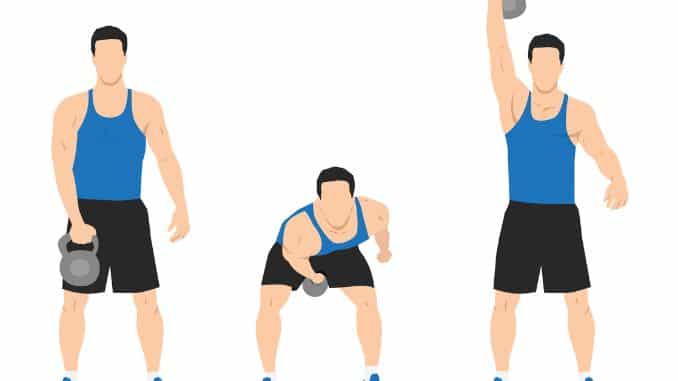
The kettlebell snatch is a full-body exercise that focuses on shoulder power and is performed using one arm to improve muscle imbalances and stability.
- Begin in an upright standing position with your feet shoulder-width apart.
- Maintain good alignment with your head, shoulders, hips, and legs.
- Hold a kettlebell in one hand.
- After that, engage your core muscles.
- Bend your knees as you hinge through your hips to bend your upper body forward as you swing the kettlebell between your knees.
- In one fluid motion, lift it overhead while keeping your body in a straight line.
- After that, repeat the sequence of movement with 5 repetitions.
Benefits of Kettlebell Training for Shoulders
- Improved Shoulder Stability: Kettlebell exercises engage shoulder stabilising muscles, enhancing overall stability and then helping to correct muscle imbalances.
- Increased Shoulder Mobility: Movements like the kettlebell windmill and overhead press improve your range of motion.
- Strengthens Rotator Cuff Muscles [1]: Regular kettlebell workouts bolster the rotator cuff, vital for shoulder health.
- Engages Core Muscles: Many kettlebell exercises inherently engage the core for stability, improving functional strength and balance.
- Enhances Grip Strength [3]: The unique grip of kettlebells helps to build hand and forearm strength, supporting overall upper body performance.
Creating a Kettlebell Shoulder Workout
Designing an effective kettlebell shoulder workout involves selecting a variety of exercises that target different muscle groups and then incorporating them into a balanced routine.

Here are some tips to help you create a comprehensive kettlebell shoulder workout:
- Warm-Up: Start with a warm-up that includes dynamic stretching, light cardio, and mobility drills to activate key muscles and prepare for movement. This helps increase blood flow and then reduce the risk of injury.
- Exercise Selection: Choose a variety of exercises that target different muscle groups, such as the deltoids, rotator cuff muscles, and trapezius. Incorporate both basic and advanced moves to challenge your muscles and improve overall strength and mobility.
- Compound Movements: Include exercises that work multiple muscle groups at once, such as the kettlebell windmill and Turkish get up. These compound movements enhance functional strength and coordination.
- Variety of Weights: Use a range of kettlebell weights and sizes to challenge different muscle groups and prevent plateaus. Adjust the weight based on your fitness level and the specific exercise.
- Rest and Recovery: Incorporate rest and recovery into your workout routine to allow for muscle growth and repair. This is crucial for preventing overtraining and ensuring long-term progress.
The Shoulder and The Use of a Kettlebell
We are going to talk about the shoulder and the use of a kettlebell. We also discuss the greatness of the kettlebell as a tool or equipment to use for exercises, particularly if you’ve got bad shoulders or may want to get stronger shoulders.
If you look at the way the kettlebell is shaped and how it fits in your arm when you are holding it, especially if you are holding it up high. Unlike a traditional dumbbell, it is not straight up and bound.
The bell’s weight is not pushing straight down vertically on your arm. The weight is behind the bar and not right on the top.
Your shoulders are pulled into alignment as a result of the way you develop.

By doing that, what it does is it automatically gives you that stretching on the rib cage, a little bit of stretching in your lat, and then you find it all automatically pushing you into alignment. This angle of your body drives your shoulder into its sock.
It is the same as where you can see your ears and shoulders placed. You find people pressing them and doing everything overhead.
You find people pressing them and doing everything overhead.
They tend to shorten their shoulders up.
If you shorten your shoulders, you pull it out of the center.
So by using the kettlebell, focusing on packing your shoulder, and using that alignment with the kettlebell.
Lifting it over your head naturally pulls you into alignment, centers your shoulder, and gets you to focus on keeping your shoulder locked in its socket.
Chris Lopez, a kettlebell expert, emphasizes the unique benefits of kettlebell training for shoulder health. He states, “Many people prone to shoulder pain don’t experience issues when using kettlebells. The kettlebell’s shape and grip help align the shoulders, promoting better form.”
Chris explains that the kettlebell’s design allows for natural movement. Unlike traditional dumbbells, kettlebells do not push straight down vertically, which helps maintain proper shoulder alignment. This makes kettlebell exercises ideal for those looking to strengthen their shoulder muscles while minimizing the risk of injury.
Conclusion
Incorporating kettlebell shoulder exercises into your fitness routine can lead to significant improvements in upper body strength, stability, and mobility.
Whether it’s the kettlebell shoulder press or the dynamic kettlebell swing, these exercises are designed to challenge your upper body while promoting proper form.
Start your kettlebell journey today and unlock your full potential.
With consistent practice, you’ll notice enhanced shoulder strength and then improved performance in your workouts.
Don’t forget to explore the many kettlebell exercises available and find what works best for you.
Happy training!
Ready to take your workouts to the next level? Discover 10 powerful compound kettlebell exercises that build full-body strength, boost endurance, and torch calories. Grab your kettlebell and let’s get stronger—one rep at a time!
Frequently Asked Questions
Are kettlebell swings a shoulder workout?
Kettlebell swings primarily target the hips, glutes, and core, but they also engage the shoulders for stabilization.
Which shoulder exercises have the highest muscle activation?
Exercises like the strict overhead press, push-ups, and lateral raises are highly effective for shoulder activation.
Is kettlebell cardio or strength?
Kettlebell training can be both; swings and other dynamic movements provide cardio benefits, while lifts build strength.

